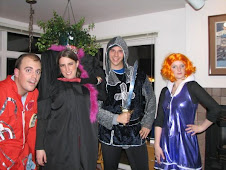Did you know Google Earth can do anything??
Well, practically. Besides basic functions like measuring distance, identifying coordinates, labeling borders, and zooming in on landscape features, Google Earth can help you:
- learn to fly a plane!
- view constellations!
- listen to penguins in Antarctica!
- pick a cause! (find about about the Crisis in Darfur, Water Issues, Endangered Species, and more)
- display historic maps! (population density, moving hurricane images, geology...)
And this barely scratches the surface. Needless to say, I bit off a little more than I could chew. But I persevered, muddled through, and have come out with a pretty sweet project idea that involves History, Technology, Geography, and Language Arts.
Vision
Read a historical novel of your choice. Connect the narrative to historical events. Present the book and its history through a Google Earth "tour". Imagine - a geographic approach to presenting information. We've all mastered Power Point, now let's explore a fun, new tool.
This project would ideally fall towards the end of semester one in a World History class (it could very easily be modified to fit US History). It takes a good two weeks of class time to master the necessary skills and create the final project, and more for presentation time. To make this a more realistic use of curriculum time it would be grand to draw on these skills during the second semester as well, hence positioning this project at the end of first semester.
Another idea for maximum time efficiency: collaborate on this project with a language arts teacher. Ideally students would have work time in both courses, and the final project rubric and expectations could be modified to include more language arts-themed information.
A third idea: use Google Earth during the semester previous to assigning the project. When discussing current events, zoom in on the area in Google Earth. Play with the different layers to find more information about the area or event. When the project commences, students will already have been exposed to many of the skills they must master. It might be possible to skip the first three lesson plans.
View my lesson plans and worksheets (the grand plan comes together in lesson plans 4-6):
Lesson Plan 1 Worksheet I Worksheet I Key
Lesson Plan 2 Worksheet II Worksheet II Key
Lesson Plan 4 Worksheet IV Worksheet V
Reflection
One thing I am still looking into is "publishing" such projects on the web. Though I created a project to go along with Anne Frank: The Diary of a Young Girl, it remains viewable solely on my home computer. In order to demonstrate this project for my students, I will have to recreate the tour on my school computer, buy Google Earth Pro, or submit it to the Google Earth community for publishing. Buying the pro version is something I might ask the school district to do should I make more lesson plans using this platform. This would also allow students to share their classwork with their parents and work on projects outside of school.
Google Earth is a fascinating tool with tons of potential for classroom use.
The biggest classroom challenge? Keeping students focused on the task at hand. There is so much cool stuff to play with!
The biggest teacher challenge? Keeping myself focused on the task at hand when developing lesson plans. There is so much cool stuff to play with!
I hope you enjoy reading and using as much as I enjoyed experimenting and creating.
